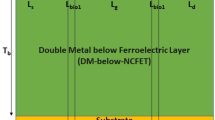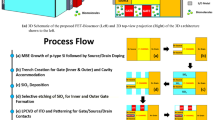Abstract
In this paper, a novel biomolecule nanocavity immobilization in a dielectric modulated triple-hybrid metal gate-all-around (THM-GAA) junctionless (JL) NWFET has been proposed to improve sensitivity for detecting various diseases. A comparative analysis of the dielectric modulated triple-hybrid metal gate-all-around JL-NWFET biosensor has been carried out with unique and double-hybrid metal gate (DHM) transistors immobilizing different biomolecules (neutral) such as streptavidin, \({\text{ChO}}_{X}\), APTES, uricase, and biotin in the nanogap cavity region. The simulation results were analyzed using the Atlas-3D device simulation tool. The work shows that higher work-function and higher dielectric materials near the drain suppress/overcome short-channel effects and quantum mechanical tunneling caused by hot-carrier and electron scattering due to a high electric field and saturation velocity. The impact of neutral biomolecules on device output characteristics such as switching (\(I_{{{\text{ON}}}} /I_{{{\text{OFF}}}}\)) ratio, shifting threshold voltage (\(\Delta V_{{{\text{th}}}}\)), intrinsic voltage gain \(\left( {g_{m} /g_{d} } \right)\), drain off-current sensitivity \(\left( {S_{{I_{{{\text{OFF}}}} }} } \right)\), subthreshold slope, transconductance \(\left( {g_{m} } \right)\), output conductance \(\left( {g_{d} } \right)\), surface potential and output resistance \(\left( {1/g_{d} } \right)\) has been studied. Sensitivity of the proposed device for detecting a specific neutral biomolecule was examined using a drain off-current ratio, and the results were compared with available works. The result shows a higher sensitivity in a triple-hybrid metal gate transistor than a unique and double-hybrid metal gate transistor in addition to available works, as we have discussed under the results and discussion section. For example, drain off-current sensitivity (\(S_{{I_{{{\text{OFF}}}} }}\)) in a triple-hybrid metal gate when a biotin biomolecule is immobilized uniformly in the nanogap cavity was 217.6% and 46.43% higher than a unique and double-hybrid metal gate transistor, respectively. We found that the proposed device can detect a specific biomolecule to diagnose different biomarkers for diseases such as breast and lung cancer.










Similar content being viewed by others
Reference
Y.-C. Syu, W.-E. Hsu, and C.-T. Lin, Review—field-effect transistor biosensing: devices and clinical applications. ECS J. Solid State Sci. Technol. 7, Q3196 (2018).
H.C. Lau, T.E. Bae, H.J. Jang, J.Y. Kwon, W.J. Cho, and J.O. Lim, Saliva-based screening approach for Alzheimer’s disease via the cell-oriented ion-sensitive field-effect transistor. Sens. Lett. 12, 1096 (2014).
N. Lu, A. Gao, P. Dai, H. Mao, X. Zuo, C. Fan, Y. Wang, and T. Li, Ultrasensitive detection of dual cancer biomarkers with integrated CMOS-compatible nanowire arrays. Anal. Chem. 87, 11203 (2015).
V.M. Generalov, O.V. Naumova, B.I. Fomin, S.A. Pyankov, I.V. Khlistun, A.S. Safatov, B.N. Zaitsev, E.G. Zaitseva, and A.L. Aseev, Detection of ebola virus VP40 protein using a nanowire SOI biosensor. Optoelectron. Instrum. Data Process. 55, 618 (2019).
K.Y. Park, M.S. Kim, and S.Y. Choi, Fabrication and characteristics of MOSFET protein chip for detection of ribosomal protein. Biosens. Bioelectron. 20, 2111 (2015).
C. Gouvea, Biosensors for health applications, in Open Access Peer-Reviewed Chapter, edited by Pier Andrea Serra (IntechOpen, Universidade Federal de Alfenas, Brazil, n.d.).
D. Sarkar, and K. Banerjee, Proposal for tunnel-field-effect-transistor as ultra-sensitive and label-free biosensors. Appl. Phys. Lett. 100, 143108 (2012).
Y. Pratap, M. Kumar, S. Kabra, S. Haldar, R.S. Gupta, and M. Gupta, Analytical modeling of gate-all-around junctionless transistor based biosensors for detection of neutral biomolecule species. J. Comput. Electron. 17, 288 (2018).
B. Kumar, and R. Chaujar, TCAD temperature analysis of gate stack gate all around (GS-GAA) FinFET for improved RF and wireless performance. Silicon 13, 3741 (2021).
J.T. Qu, H.M. Zhang, X.B. Xu, and S.S. Qin, Study of drain induced barrier lowering(DIBL) effect for strained Si NMOSFET. Procedia Eng. 16, 298 (2011).
I. Sarangadharan, A.K. Pulikkathodi, C.-H. Chu, Y.-W. Chen, A. Regmi, P.-C. Chen, C.-P. Hsu, and Y.-L. Wang, Review—high field modulated FET biosensors for biomedical applications. ECS J. Solid State Sci. Technol. 7, Q3032 (2018).
T. Windbacher, V. Sverdlov, and S. Selberherr, Biotin-streptavidin sensitive BioFETs and their properties. Commun. Comput. Inf. Sci. 52, 85 (2010).
P. Ambhorkar, Z. Wang, H. Ko, S. Lee, K.I. Koo, K. Kim, and D.I.D. Cho, Nanowire-based biosensors: from growth to applications. Micromachines 9, 1 (2018).
V.P. Georgiev, M.M. Mirza, A.I. Dochioiu, F. Adamu-Lema, S.M. Amoroso, E. Towie, C. Riddet, D.A. Maclaren, A. Asenov, and D.J. Paul, Experimental and simulation study of silicon nanowire transistors using heavily doped channels. IEEE Trans. Nanotechnol. 16, 727 (2017).
J.-H. Lee, E.-J. Chae, S. Park, and J.-W. Choi, Label-free detection of γ-aminobutyric acid based on silicon nanowire biosensor. Nano Converg. 6, 6 (2019).
C. Vu, Field-effect transistor biosensors for biomedical applications: recent advances and future prospects. Sensors 19, 4214 (2019).
C. Buzea, Nanomaterials and nanoparticles : sources and toxicity. Biointerphases (2007).
S. Prasad, Nanobiosensors: the future for diagnosis of disease? Nanobiosensors Dis. Diagnosis 3, 1 (2014).
Y. He, C. Fan, and S.T. Lee, Silicon nanostructures for bioapplications. Nano Today 5, 282 (2010).
A.C.M. de Moraes, and L.T. Kubota, Recent trends in field-effect transistors-based immunosensors. Chemosensors 4, 20 (2016).
M.N. Omar, A.B. Salleh, H.N. Lim, and A. Ahmad Tajudin, Electrochemical detection of uric acid via uricase-immobilized graphene oxide. Anal. Biochem. 509, 135 (2016).
J. Y. Hung, Y. B. Manga, Y. J. Chen, H. M. Huang, W. L. Yang, and C. C. Wu, P16 INK4a detection using an ultra-sensitive silicon nanowire field effect transistor. In Proc. - 2018 7th Int. Symp. Next-Generation Electron. ISNE 2018 1 (2018).
S. Singh, B. Raj, and S.K. Vishvakarma, Analytical modeling of split-gate junction-less transistor for a biosensor application. Sens. Bio-Sensing Res. 18, 31 (2018).
B.M. Lowe, K. Sun, I. Zeimpekis, C.K. Skylaris, and N.G. Green, Field-Effect sensors-from PH sensing to biosensing: sensitivity enhancement using streptavidin-biotin as a model system. Analyst 142, 4173 (2017).
K. Kim, C. Park, T. Rim, M. Meyyappan, and J. S. Lee, Electrical and PH sensing characteristics of si nanowire-based suspended FET biosensors, In 14th IEEE Int. Conf. Nanotechnology, IEEE-NANO 2014 3, 768 (2014).
A. Goel, S. Rewari, S. Verma, and R. S. Gupta, Dielectric modulated triple metal gate all around MOSFET (TMGAA)for DNA bio-molecule detection. In 2018 IEEE Electron Devices Kolkata Conf. 1, 337 (2019).
Y. Chen, R. Ren, H. Pu, X. Guo, J. Chang, G. Zhou, S. Mao, M. Kron, and J. Chen, Field-effect transistor biosensor for rapid detection of ebola antigen. Sci. Rep. 7, 4 (2017).
G. Dhiman, Investigation of junction - less double gate MOSFET with high - k gate - oxide and metal gate layers. Int. J. Innov. Res. Sci. Eng. Technol. 8, 289 (2019).
V. P. Georgiev, A. I. Dochioiu, F. A. Lema, S. Berada, M. M. Mirza, D. J. Paul, and A. Asenov, Variability Study of High Current Junctionless Silicon Nanowire Transistors, in 2017 IEEE 12th Nanotechnology Materials and Devices Conference, NMDC 2017, Vol. 2018–Janua (2018), pp. 87–88.
A. Kumar, M.M. Tripathi, and R. Chaujar, Comprehensive analysis of sub-20 nm black phosphorus based junctionless-recessed channel mosfet for analog/RF applications. Superlattices Microstruct. 116, 171 (2018).
R. Narang, M. Saxena, and M. Gupta, Investigation of dielectric modulated (DM) double gate (DG) junctionless MOSFETs for application as a biosensors. Superlatt. Microstruct. 85, 557 (2015).
V. Kumar, R. Gupta, R. Preet, P. Singh, and R. Vaid, Performance analysis of double gate N-FinFET using high-k dielectric materials. Int. J. Innov. Res. Sci. Eng. Technol. 5, 13242 (2016).
B. Kumar, and R. Chaujar, Fin aspect ratio optimization of novel junctionless gate stack gate all around (GS-GAA) FinFET for analog/RF applications. Microelectron. Circ. Syst. Lect. Not. Electr. Eng. 755, 59 (2021).
L. Feilong, L. Yue-yang, L. Ling, Z. Guofu, J. Xiangwei, and L. Jun-wei, Three-dimensional mechanistic modeling of gate leakage current in high- κ MOSFETs. Phys. Rev. Appl. 10, 1 (2020).
M. W. Rony, P. Bhowmik, H. R. Myler, and P. Mondol, Short Channel Effects Suppression in a Dual-Gate Gate-All-around Si Nanowire Junctionless NMOSFET, in Proc. 9th Int. Conf. Electr. Comput. Eng. ICECE 2016 538 (2017).
N. Gupta, and R. Chaujar, Optimization of high-k and gate metal workfunction for improved analog and intermodulation performance of gate stack (GS)-GEWE-SiNW MOSFET. Superlatt. Microstruct. 97, 630 (2016).
B. Cheng, M. Cao, R. Rao, A. Inani, S. Member, P. Vande Voorde, W.M. Greene, J.M.C. Stork, Z. Yu, S. Member, P.M. Zeitzoff, S. Member, J.C.S. Woo, and S. Member, The impact of high- gate dielectrics and metal gate electrodes on sub-100 Nm MOSFET’s. IEEE Trans. ELECTRON DEVICES 46, 1537 (1999).
O.A. Books, Work function setting in high-k metal gate devices. INTECH 32, 137–144 (2013).
G. James, S. Joseph, and V. Mathew, The influence of metal gate work function on short channel effects in atomic-layer doped DG MOSFETs. J. Electron Dev. 8, 310 (2010).
S. Piermarini, D. Migliorelli, G. Volpe, R. Massoud, A. Pierantozzi, C. Cortese, and G. Palleschi, Uricase biosensor based on a screen-printed electrode modified with prussian blue for detection of uric acid in human blood serum. Sensors Actuators B Chem. 179, 170 (2013).
N. Lu, P. Dai, A. Gao, J. Valiaho, P. Kallio, Y. Wang, and T. Li, Label-free and rapid electrical detection of HTSH with CMOS-compatible silicon nanowire transistor arrays. ACS Appl. Mater. Interfaces 6, 20378 (2014).
V. Narendar, R. Mishra, S. Rai, R.A. Mishra, and C. Engineering, Threshold voltage controlS chemes infinfets. Int. J. VLSI Des. Commun. Syst. 3, 175 (2012).
D. S. Software, ATLAS User ’ s Manual, Vol. II (1998).
D. S. Software, Atlas User ’ s Manual (2016).
J. Sarvas, and J. Spanier, A direct approach to solving the drift-diffusion model equations for use in certain MOSFET devices. Math. Comput. Model. 22, 17 (1995).
S. Selberherr, Deterministic solvers for the boltzmann transport equation (Springer, n.d.).
S. Scaldaferri, G. Curatola, and G. Iannaccone, Direct solution of the boltzmann transport equation and Poisson-Schrödinger equation for nanoscale MOSFETs. IEEE Trans. Electron Devices 54, 2901 (2007).
T. Ewert, Advanced TCAD simulations and characterization of semiconductor devices (2006).
L. Arivazhagan, D. Nirmal, A. Jarndal, H.F. Huq, S. Chander, S. Bhagyalakshmi, P. Kumar, J. Ajayan, and A. Varghese, Applicability of double channel technique in AlGaN / GaN HEMT for future biosensing applications. Superlattices Microstruct. 160, 107086 (2021).
T. Goudon, V. Miljanović, and C. Schmeiser, On the shockley-read-hall model: generation-recombination in semiconductors. SIAM J. Appl. Math. 67, 1183 (2007).
N. Thapa, and L. Maurya, Performance advancement of high-K dielectric MOSFET. Int. J. Innov. Adv. Comput. Sci. 3, 98 (2014).
N. Sachdeva, M. Vashishath, and P.K. Bansal, Effect of gate work-function on gate induced drain leakage of MOSFETs. IJCEM Int. J. Comput. Eng. Manag. 21, 11 (2018).
A. Kumar, D. Kaur, M. M. Tripathi, and R. Chaujar, Reliability of high-k gate stack on transparent gate recessed channel (TGRC) MOSFET, In 2017 International Confernce on Microelectronic Devices, Circuits Systems ICMDCS 2017 2017–Janua, 1 (2017).
N. Bagga, and S. Dasgupta, Surface potential and drain current analytical model of gate all around triple metal TFET. IEEE Trans. Electron Dev. 64, 606 (2017).
K.V. Cartwirght, Derivation of the exact transconductance of a FET without calculus. Technol. Interface J. 10, 7 (2009).
H. Im, X.J. Huang, B. Gu, and Y.K. Choi, A dielectric-modulated field-effect transistor for biosensing. Nat. Nanotechnol. 2, 430 (2007).
E. Rahman, A. Shadman, and Q.D.M. Khosru, Effect of biomolecule position and Fi Ll in factor on sensitivity of a dielectric modulated double gate junctionless MOSFET biosensor. Sens. Bio-Sensing Res. 13, 49 (2017).
W. F. Perina, J. A. Martino, S. Member, P. G. D. Agopian, and S. Member, Intrinsic voltage gain and unit-gain frequency of omega-gate nanowire SOI MOSFETs, in2019 34th Symposium on Microelectronics Technology and Devices, 1 (2019).
J.H. Huang, H. Liu, M.C. Jeng, and P.K. Ko, A physical model for MOSFET output resistance. IEDM Tech. Dig 569, 572 (1992).
Funding
The study was funded by Ethiopia's Ministry of Higher Education and India's Delhi Technological University.
Author information
Authors and Affiliations
Corresponding author
Ethics declarations
Conflict of interest
The authors declare that they have no conflict of interest.
Additional information
Publisher's Note
Springer Nature remains neutral with regard to jurisdictional claims in published maps and institutional affiliations.
Rights and permissions
About this article
Cite this article
Getnet, M., Chaujar, R. Sensitivity Analysis of Biomolecule Nanocavity Immobilization in a Dielectric Modulated Triple-Hybrid Metal Gate-All-Around Junctionless NWFET Biosensor for Detecting Various Diseases. J. Electron. Mater. 51, 2236–2247 (2022). https://doi.org/10.1007/s11664-022-09466-1
Received:
Accepted:
Published:
Issue Date:
DOI: https://doi.org/10.1007/s11664-022-09466-1




